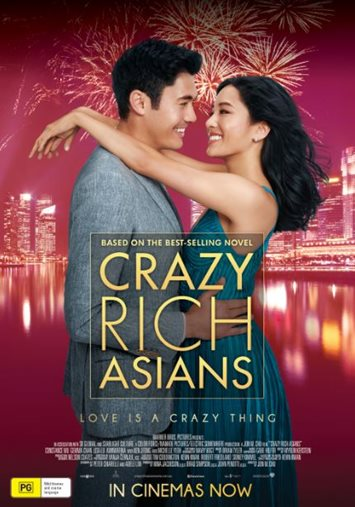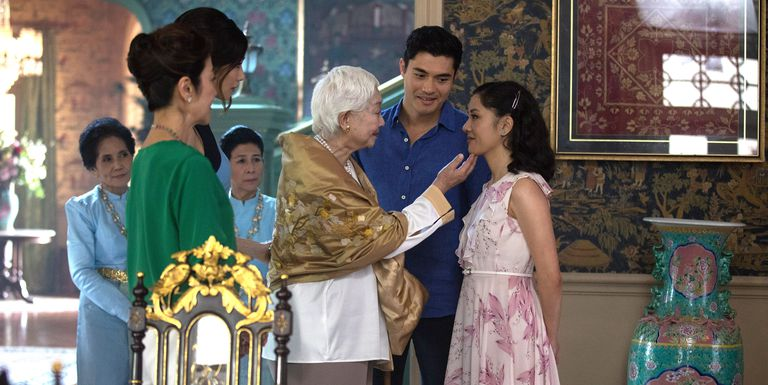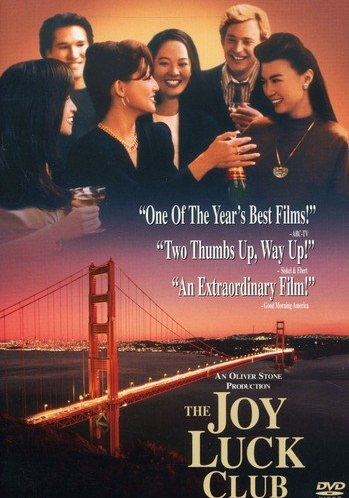
On August 15th, Crazy Rich Asians opened in the United States. That stormy Wednesday evening, a tornado warning was issued just as I pulled into the theater’s parking lot. Though the Bloomington theater was barely half full, the film has gone on to be sold out across the country, earning 26.5 million its first weekend. As the first Asian-led and Asian-cast movie in twenty-five years, it has been hailed as an entertainment milestone in diversity. (See “The Connection Between ‘The Joy Luck Club’ and ‘Crazy Rich Asians,’” https://www.npr.org/2018/08/18/639822957/the-connection-of-the-joy-luck-club-and-crazy-rich-asians)

The plot, very simply, is about a Chinese-American college professor (Rachel) who visits her boyfriend Nick’s family in Singapore only to find out not only are they “crazy rich,” they also do not think very highly of her as an Asian American raised by a single mother. Most of the movie is set on the lush island country at the tip of the Malay peninsula, and while a brief detour into a mouth-watering food spot–shot on location at Newton Food Centre–introduces us and Rachel to Singapore, not much time is spent on the details of the place in which the romance and family drama unfolds.

I left the theater that night wanting to know more about Chinese Singaporeans, especially intrigued by the detail about Nick’s family and how they had emigrated to Singapore and made their fortune. What was that history, and why did the film skip over it so quickly?
It didn’t take long for me to find voices who were framing the film and its representation of a place and its people quite differently. Some are Chinese Singaporeans themselves like Kirsten Han who wrote an article that says the movie “gets Singapore wrong.” She writes, “The all-East Asian cast of Crazy Rich Asians is also a misrepresentation of Singapore at the most basic level, obscuring Malay, Indian, Eurasian, and more populations who make the country the culturally rich and unique place that it is.” Why does this matter? It all has to do with power and historical context.
Chinese Singaporeans have long enjoyed privilege and power in the Southeast Asian country where they have been the ethnic majority since 1826, despite the fact that it was a British-controlled colony at that time. By 1877, an administrative body called the Chinese Protectorate was put in place to ensure the well-being of Chinese Singaporeans, many of whom were immigrant laborers and some of whom were forced into prostitution.

Almost a century later and following a brief period of Japanese rule, Singapore became a fully independent republic and elected Lee Kuan Yew as its first Prime Minister in 1959. Yew was a Cambridge-educated, fourth-generation Chinese Singaporean, and he came to be known as the “founding father” of Singapore, ushering the new republic from “third- to first-world in a single generation.” Since that time, Singapore has never had a non-Chinese prime minister. All of this is part of why some scholars and cultural theorists refer to the situation in Singapore as a form of “Chinese supremacy.”
Having read the critiques and talked to friends about the movie, I see the film as an opportunity to learn and reflect about the different racist global histories that persist in popular media.
In a conversation with Jeff Yang about the choice not to explain the rules of mahjong in the movie, CRA director John Chu said, “We didn’t want to give people an excuse to think of this world as some kind of obscure, exotic fantasyland — this is a real place, with real culture, history and tradition, and instead of just giving them answers to their questions, we want them to have conversations.” The movie itself becomes a fun and emotional way to begin a conversation that hopefully leads us to a better understanding of Singapore, classism, colorism, and what our needs and expectations for representation tell us about what to look for next.

If you are one of those people that likes to read the book before they see the movie, Wells Library can help! Crazy Rich Asians: https://iucat.iu.edu/catalog/15266801. And you can come to Media Services to find The Joy Luck Club, the movie that inspired similar questions a full 25 years ago: https://iucat.iu.edu/catalog/10023013, along with a wide variety of other Asia-focused cinema milestones. AL
Anni Liu is a graduate student in Creative Writing at IU and a published poet and essayist. For a brief analysis of the history of Chinese cinema, see her previous blog post entitled “Chinese Cinema: Classics and New Trends in Context,” Media Beat blog, July 3, 2018: https://blogs.libraries.indiana.edu/mediabeat/2018/07/03/chinese-cinema-classics-and-new-trends-in-context/
Sources Cited:
Leave a Reply